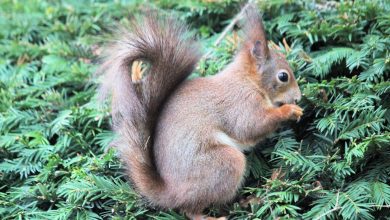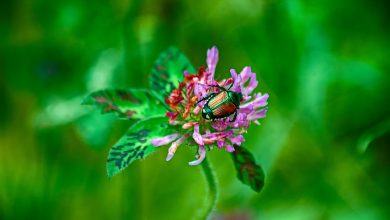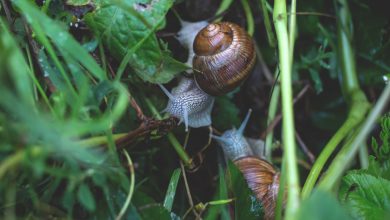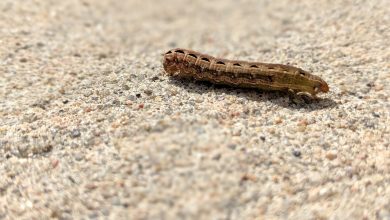Common Insect, Fungal, and Animal Garden Pests
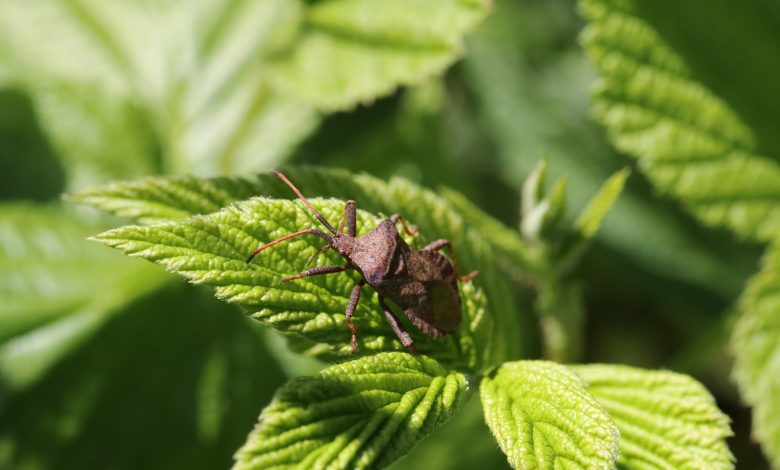
Garden pests are basically inevitable at some point, though there are a few ways that pests can be prevented. Prevention is obviously the goal, but it is just not realistic to think that your garden can always be pest-free.
The best thing to do is be ready to deal with a pest when it does rear its ugly head. Prepare for pests by diligently observing your plants. Keep an eye on the foliage. Is it changing color? Are holes suddenly appearing in the leaves? Are the leaves continually falling off the plant? All of these are good indicators that something may be wrong. If you notice any of these symptoms, inspect the plant carefully. Look for insects on the plant. They may be on the stem, to the top of the leaves, or even at the bottom side of the leaves. From here, try to identify the insect so you know how to deal with it. All insects have distinguishing features that can tell you what you are dealing with. Your goal should be to find the problem early. Deal with the pest at the beginning of the infestation to reduce the amount of damage they can cause.
Pest Prevention
Cleanliness
Obviously, the best scenario for a garden is to not deal with pests at all. Though this is not possible, there are ways to try and prevent them. The first is cleanliness. In a garden, cleanliness refers to plant debris that can build up. The debris comes from plants naturally shedding their leaves and flowers, dead weeds that have been pulled, or any other items that may land there. The debris is an excellent place for insects to hide and breed. Keep your garden as weed and debris-free as possible to help reduce the chance of pests.
Companion Plants
Companion planting is another way to mitigate insect pest infestations and is extremely helpful in food gardens. This practice is essential because most insects only attack specific plants. If you plant the specific vegetable plants together, there is more opportunity for insects to attack. In addition, there is so much more food available for the insects, so they are able to procreate rapidly. The procreation is what really does a number on the plant health. So be aware of what you are planting and what attacks it. If two of your plants have the same predators, don’t plant them together.
Watering
Watering plants properly is another way to prevent pests. While we often think of pests like insects, there are actually several other types. One of these is a fungal pest. Fungal diseases are usually spread by water or are caused by standing water. So overwatering a garden can be extremely harmful. When the plants have access to too much water, they are unable to use up all the water in the soil. This causes the soil to stay moist for too long, and when the water just sits in the soil, the fungus can form. The fungus can now attack the plants’ roots, leaves, or flowers. Wet soil is also a place that some insect pests like to hide and breed. Due to all the negative implications of overwatering, it is quite clear that a gardener should be conscientious as to how much water the plants receive.
It is important to note that underwatering can be just as harmful to a plant. A plant relies on water to survive and be healthy. A plant that is lacking water becomes very weak. Its ability to fight off pests and fungal disease is reduced. A weak plant is an easy target and therefore much more likely to be attacked by insects.
Fertilizer
Proper and regular fertilizing is another way to reduce potential garden pests. Proper feeding helps a plant to grow strong and healthy. Like a healthy person, a healthy plant can ward off illness. Applying all-purpose garden fertilizer during the growing season is a great way to make sure your plants stay healthy.

Common Insect Pests
Insect pests are probably one of the most annoying problems in a garden. Not only can they be devastating to a garden, but they can be gross to deal with. Each insect poses its own challenges and requires special treatment for eradication. Here are a few insect pests you may come across in your garden adventures.
Caterpillars
Caterpillars can be fun to watch when you don’t have a garden to take care of. When left to their own devices, they can feast on stalks and stems in a matter of hours. These moth and butterfly larvae are known for their elongated body that is set upon its dozens of legs. Their heads are protected by a hard exoskeleton that stays with them up until the pupae stage. While their colors and outward appearance can vary, the majority of these garden eaters have the same intent when they spot leaves: to eat everything.
Caterpillars use stems and leaves as fuel to help them turn into pupae. They love plants like snapdragons, violets, carrots, and more. If you suspect you may have a few of these visitors, there are a few red flags to look out for:
- Eggs: Caterpillar eggs are left behind by butterflies and moths. Pay attention to any of these winged creatures coming to your yard. They often leave behind tiny particles that are actually their eggs. They can be laid one by one or in groups. If you spot yellow, white, green, or brown specks on your leaves, they could be caterpillars waiting to hatch.
- Leaves: Another sign of a caterpillar’s presence is in a plant’s leaves. Caterpillars like to get the most they can out of the foliage. They start from the edge of the blade and work their way inward. Check your leaves to see if any bites look like this.
- Waste: The waste that caterpillars leave look like tiny black dots. These larvae tend to go to the bathroom near where they eat. Inspect your leaves for any specks that resemble black pepper flakes.
As soon as you spot one, you must be proactive before it becomes a full-blown infestation. There are several ways to eliminate caterpillars from your garden. If you are trying to go the more natural route, try placing cardboard around all of your plants. Scientists have discovered that there is something in this material that the larvae don’t like. This method is time-consuming, but it helps to keep your garden organic if that is a goal.
Another way to handle this infestation is by hunting for them. Take the time to go through all of your plants to locate all caterpillars. Then, take a bucket of hot water and dish soap and drop them in the container to drown. This method may have to be done a few times to eliminate the pests.
A third method to try is using caterpillar poison. There are a variety of mixtures you can use that are available in stores, but the most effective solution uses Bacillus thuringiensis as its main ingredient. You need to either dust or mist the toxin directly onto your plants. Then, wait for the leaves and stalks to start being eaten. This poison is extremely harmful to the pest, but it is safe for pets, humans, and bees. You can re-apply as necessary.
Snails and Slugs
While these aren’t quite an insect, snails and slugs are other common pests found in many gardens. When you spot a snail or slug in your garden, there are many more to come your way. These slimy things come in at night to eat up your plants and flowers. They love to dine on plants that include succulents and flowers of almost any variety.
When they bite through your leaves and flowers, they leave behind holes that have smooth edges. Snails and slugs use their tongues to cut through the plant, so their bites are distinctive. To confirm that they are in your garden, look for the silvery mucous trails that they make as they sneak their way from stalk to stalk.
During the day, these pests like to rest in dark and damp places. Get rid of any old wooden boards, stones, weeds, or debris that can become a safe haven for them. For those areas where you can’t get rid of this type of environment, you need to capture and kill them.
One effective way to eliminate these intruders is by sprinkling salt or saltwater directly on their bodies. When they come in contact with salt, it dries them up and kills them within minutes. Sprinkle salt in low lying hedges, vines, and other dark and damp areas they could hide in.
You can also set up traps to capture the slugs. Pour beer or yeast in a shallow bowl and place them near areas you have seen them visit. They are attracted to the yeast smell and ultimately fall in and drown themselves as a result. Leave the bowl out for several days at a time and replace the liquid as necessary. If you prefer to use chemicals, consider baits that include molluscicides. Place the baits throughout your yard to capture as many as you can. You should note, however, this is only a short-term remedy to your intrusion problem. They could come back as soon as you remove the chemical from your yard.
Japanese Beetles
Japanese beetles are particularly offensive in a garden. They feast on any plant they can without discrimination. They are easily identifiable by their metallic greeny blue heads and bronze-colored shell. As soon as you see one of these in your garden, deal with it quickly. An adult bug can do significant damage on their own, but it is very likely that, where there is one, there are many.
To get rid of a beetle population can be somewhat taxing. If you aren’t opposed to insecticides, visit a local nursery, and they can provide you with chemicals that are approved for residential use in your area. If you prefer a more natural approach, try mixing one teaspoon of dish soap into one cup of vegetable oil. Then mix with eight cups of water and one cup of rubbing alcohol. Spray this mix directly on to the bugs. This process needs to be repeated every ten to fourteen days until the insect population is entirely eradicated.
Aphids
Aphids are another garden nuisance that can wreak havoc on your plants if you aren’t paying close attention. These bugs are known for their unique and almost pear-like shape. They also have six long legs and antennae that help them feel their way across plants and leaves, and they come in many colors, including green, brown, black, red, white, and yellow.
These insects can survive in almost any type of climate. They also multiply quickly, so it is essential to get rid of aphids at the first sign of them. Adult aphids are less than an inch wide and hard to spot at first glance. These bugs like to eat a wide variety of plants. They feed on the nectar and juices of a plant and tend to make the underside of leaves their temporary home.
Some signs to look out for include curling, shriveling, or yellowing leaves and stunted growth, as well as a sticky film that can be found on leaves and stems. This substance may come from the aphids themselves. When they lap up the sap and nectar, they often leave a liquid behind. This waste can also attract other bugs like ants and flies. If left on the plants, the gooey sap can cause mold and fungus. If you see this, turn the leaf over. On the underside, you may find clusters of this nasty garden pest.
If you have determined you have aphids in your garden, you need to act fast. Here are some solutions that can help you get rid of these insects for good:
- Cold Water: You can spray ice cold water on the leaves to get the aphids to fall off the plant. When they tumble to the ground, they usually can’t find their way back to where they were. You can scoop them up from here and place them in hot soapy water to drown them.
- Flour: Try using flour on the leaves and base of your plants and flowers. The household ingredient doesn’t deter the aphids, but when they get the powder in their system, it causes discomfort and constipation. The aphids can either fall off your crops or die as a result.
- Cayenne Pepper: Cayenne pepper is also a useful item to use when eliminating aphids. Mix the pepper with dish soap and water and spray on the areas that are affected. The oils in pepper irritate the aphid and prevent them from eating the leaves and stalks.
- Diatomaceous Earth: This is another non-toxic way to kill off the aphids. It is an organic material that is best used when your flowers are not in bloom. While it does kill off aphids, it can also negatively affect bees, butterflies, and other non-pests.
- Poisons: While these are more natural ways to get rid of these pesky bugs, stores also sell man-made poisons that can be applied to your plants. If you choose this method, make sure you read the directions in full on how to use the solution. Also, check if the poison is toxic to humans and pets. If it is, you need to keep the more vulnerable members of your household away for a time.
Mosquitoes
Who doesn’t despise this familiar garden pest? Mosquitoes are an insect that can have you seeing red as soon as you step outside and into your yard. Their bites make us itch for days, and they are also known to carry diseases like West Nile and Zika. These intruders find their victims by the smells we give off. These scents include sweat, perfumes, and carbon dioxide. This may be why some humans are more attractive to mosquitoes than others – it all lies in our odor.
If your backyard and garden are prone to attracting these insects, you can help keep the population down with just a few quick tips:
- Throw Away Standing Water: If you have any standing water that is not treated, pour it out immediately. Mosquitoes are known to lay their eggs here by the hundreds. You can also add apple cider vinegar, soap, or bleach to any remaining damp areas to ensure you have killed the eggs and larvae thoroughly.
- Plants: There are also mosquito repellant plants that you can place in your garden and yard that can drastically lower the insect’s population:
- Lemongrass: It is a lush plant that mosquitoes stay away from. The grass contains citronella oil, which has been proven to repel the pests. Lemongrass grows best in warm and tropical climates, but you can also pot the plant. When the weather cools, bring your plant indoors if you want to keep it thriving throughout the winter.
- Lavender: This is another fragrant smelling plant that mosquitoes don’t like. Plant these in your garden and around your yard to keep them away from your home. This flowering plant can also be dried and hung around your house to keep other flying insects away.
- Rosemary: The plant also can prevent mosquitoes from ruining your beautiful summer days and nights. Plant rosemary in your herb garden. When the stalks are fully grown, snip a handful and place them in areas where you frequent. You can also burn rosemary and use the smoke to help drive the intruders away for hours.
- Peppermint: This herb gives off a fierce fragrance that mosquitoes are known to detest. If you plant the mint directly in the ground, make sure you keep it well maintained, as it can grow fast. To counter this, sow the herb in a pot or other container. Move the pot wherever you need to so you can combat the flying bugs.
- Marigolds: These are beautiful smelling flowers that keep mosquitoes away. The golden flowers run double duty, as they pretty your garden and fend off unwanted bugs. Plant a few of these in your yard to help improve your situation.
Mealybugs
Mealybugs are soft insects that look like tiny pieces of cotton or lint. They are intriguing creatures that can do more harm than good when left to their own devices. These bugs are found in warmer climates, and they adhere to the stems, leaves, and blooms of plants. They do like to travel in masses, so you may see a larger-sized cotton ball on some of your crops.
When they feed, the mealybug uses their stylets to insert and suck the sap out of a plant. When a garden has a large presence of these bugs, you often see leaf decay and yellowing. Their destruction can also contribute to the molding of plants, as they leave sap on the foliage, much like aphids do.
When you spot a mealybug, their infestation can come quickly. Females are known to deposit hundreds of eggs at a time, usually onto the underside of leaves. After two weeks or so, the eggs hatch, and yellow nymphs start their march to other parts of the plant. This intuitive walk is how they find their eating locations as they grow bigger and more destructive.
The good news about mealybugs is that they easily perish in colder weather. So if you suspect you may have a colony in your area that is hard to pinpoint, the bugs can cease to exist after the first cold snap.
Other control methods include using rubbing alcohol to eradicate the apparent populations. Take a cotton swab or ball, dip it in the alcohol, and apply it directly to the insect. Do not pour the solution directly over your plants, as you can damage the foliage and flowers by doing this.
Neem oil can also help to stop the growth and development of the mealybug. This oil is not toxic to beneficial bugs like bees and other pollinators. Mix the neem oil with water, and spray weekly or as needed. Over time, you should see the mealybug numbers decrease dramatically.
There are pesticides and insecticides that you can use on mealybugs as well. These remedies do work fast but may be toxic to some humans and animals. Make sure what you choose is safe for your household.
To prevent further infestations, you can wash the leaves and foliage of your plants with a leaf shine solution. This water-based formula is mixed with mineral oils and is meant to be misted right on the plant.

Common Fungal Pests
Fungus in the garden is another severe pest. Fungal diseases can be a little easier to control. This is because they tend to attack very specific plants. However, they can very quickly kill a plant. Hence, they still need to be taken very seriously and dealt with in a timely manner.
Powdery Mildew
Powdery mildew is very common amongst perennial plants. It may also appear on shrubs such as roses and lilacs. It does not matter whether they are full sun plants or shade plants – powdery mildew can affect them all. The good news here is that the type of spores that develop into powdery mildew are specific to each variety of plant. This means that if your peony gets the disease, it does not mean the hosta planted beside it is going to get it as well.
Powdery mildew makes its presence known by small white spots appearing on the top side of leaves. If left untreated, the white spots spread over the entire leaf and onto the shoots and buds of the plant. There are a couple of home remedies that are quite effective for powdery mildew cases. The first is milk. Mix one part cow’s milk with ten parts water. Spray on the affected plant to clear the infection. This process may need to be repeated weekly until the plant recovers. Another home remedy is mixing baking soda with horticultural vinegar. Again, spray this on the plant weekly until the problem is gone. Be aware that using this remedy too much can cause issues in the soil. A buildup of baking soda can change the pH in the soil, making it difficult for plants to access micronutrients in the soil.
Black Knot
Black knot is extremely toxic to a plant in the plum and cherry family. Cherry trees have some of the most beautiful spring flowers. In early spring, they are covered with tons of blooms of either white flowers or pink flowers. Unfortunately, these plants can be devastated by black knot. When caught early, it is possible to get rid of the fungus. However, it is much more common for the fungus to take over the tree and cause an untimely death.
Black knot looks precisely as it sounds. It is a black ball of fungus that forms around the branches of infected trees. It usually starts on small twigs and spreads to larger branches. The knot girdles the plant and kills anything on the plant beyond the infection. When the tree is fully leafed out, the contamination is difficult to spot. It is usually discovered when infected parts of the tree die and fall to the ground.
The only way to get rid of the black knot is to cut it out of the plant. Use disinfected pruners or loppers to cut out infected areas. After each cut, you must disinfect the pruners again. Black knot is spread on contact, so tainted pruners can spread the infection from one part of the plant to another. It is also imperative to never try to eradicate black knot when the plant is wet because the disease is also spread through water.
Botrytis
Botrytis, also known as grey mold, is particularly harmful to vegetable plants. It does not discriminate amongst plants but tends to have the ability to spread rapidly through food gardens. The disease initially appears as grey spots on leaves, fruits, and shoots. The spots are mushy feeling and become fuzzy over time. Like other molds, botrytis is formed when too much moisture is present. It is especially apparent in areas with high humidity and little room for air circulation. While botrytis starts in the garden on faded flowers, it quickly spreads to the fruits produced by the plant. Unfortunately, the spread does not end there. The infection can also spread amongst harvested fruits and vegetables.
If you find botrytis in your veggie garden or in your flower garden, there are a few simple solutions. The first is to prune off infected areas of the plant. The second is to thin out the plants or shoots in the affected area. This helps to create room for air circulation. Going forward, try to water only early in the morning and only at the base of the plants.

Common Animal Pests
Another common type of pest in the garden comes in the form of animals. Animals may find your garden so enticing they just can’t help but come visit. Unfortunately, they are not very good house guests and tend to ruin all of your hard work.
Rodents
Garden rodents not only appreciate the convenient food sources your plot may have, but it also provides shelter for them throughout the day. Rats, mice, moles, and other vermin can damage your fruits, vegetables, seeds, and bulbs overnight. Their droppings can also spell disaster for your plants since they can carry types of parasites and worms that are harmful to humans. These vermin are definitely intruders you don’t want in your yard for too long.
When you are looking for signs of rodents in your yard, pay attention to potential nesting areas. Piles of leaves, sticks, and drain pipes are all perfect locations for their homes. Listen to any activity when the air is still. Typically, as the sun goes down, you can start to hear them scamper to and fro. They tend to be nighttime feeders and are most active at night and in cooler weather.
Some of these rodents also dig holes in the ground and nest there. They are usually only a couple of inches wide and can be located anywhere near your garden. As you find these small tunnels, look for droppings nearby to confirm what you have is a rodent.
Start sealing some of the nesting areas as soon as you confirm what you have. Close up holes and cover up small crawl spaces under sheds and other structures. Remove piles of leaves and other debris as well.
After you do this initial control process, it is time to get rid of the mice and moles. One method to choose is fencing. You can construct a sturdy four-foot fence around your garden to deter the rodents from coming in. It can be of any material. If you can, bend the panels back near the top to further prevent the pests from coming in. When they try to climb up the wall, they easily fall down.
You can also cage your plants if need be. These structures can be bought at your local nursery, or you can make your own out of wire. Place the cages around and over all of your plants that have been destroyed by rodents. Ensure that the wire used can withstand rodent teeth, or all of your efforts may be for nothing.
Additionally, you can set traps around your garden to capture the vermin. Take care when you place them. You don’t want yourself or anyone to step on a trap by accident. Large mouse and mole traps can easily break a bone.
Spraying castor oil around your garden can also help discourage rodents from coming in. This natural oil primarily works for gophers who tunnel through the ground and dig up bulbs and roots. Spray an ample amount of the oil at the base of the plants, and re-apply when you need to.
Rodents can be a massive problem if they are not addressed sooner rather than later. While some of these vermin, like moles, eat grubs and worms, they still can damage roots and bulbs as they look for their next meal. Be careful when handling these garden pests also. These types of animals are known to carry diseases that can be transmitted to other humans and your pets. If the infestation becomes overwhelming, don’t be afraid to consult with an exterminator to handle your needs.
Deer
Deer are huge animals that can cause severe damage to a garden. Part of the damage comes from them eating desirable plants. The other comes from the damage they do by trampling over everything in sight. There are two basic ways to repel deer. The first is to surround your garden with high fences. The deer cannot get over the fence and therefore cannot get in the garden. The second is to put hoop houses with a mesh cover over susceptible plants. The deer cannot bite through the mesh, and the plants beneath are protected.
It is important to keep in mind that, when it comes to preventing deer from attacking your garden, there may be certain laws that prevent from harming them. Whether you are in the middle of nowhere and are a hunter of if you live in suburbia and a deer accidentally wanders to your property, be careful and be sure to know what you can and can’t do to scare them away. Depending on the size of your property, another way to deter deer from coming close to a possible food source is to have motion sensor lights. This can scare them off and deter them from moving forward. Bright lights and sounds are great deterrences for a deer.
Squirrels
Squirrels are a massive problem in the garden. They dig holes wherever they want, steal fruits from vegetable plants, and munch on beautiful summer flowers. The worst thing about squirrels is when they eat one bite out of every single vegetable instead of just eating one entire vegetable. Keeping squirrels out of the garden can be a difficult task. There are chemical products that can be sprayed to act as a repellent. If you are concerned about chemicals, there are a couple of other options.
Try adding a layer of mulch to the garden. Squirrels do not like mulch, so they avoid the area. You can also try spreading a layer of chili pepper flakes around susceptible plants. Alternatively, try to distract them by providing a food source to the squirrels away from the garden area. If none of these deter your neighborhood squirrel from enjoying your crops before you, consider visiting your local hardware or hunting shop and investing in bear urine. There are squirrel repellents available that one can apply to their garden without damaging their crops. If you are a bit more technologically inclined, there are also garden features that emit a large buzz that can deter squirrels from going near your garden.
The Road to a Healthy Garden
Pests are inevitable in the garden. Insects, fungus, and parasites are a natural part of our ecosystem. To keep your yard looking its best, follow these gardening ideas to deal with pests. The most essential gardening tip here is to deal with any pest problems quickly and efficiently. When left too long, the problem multiplies and becomes much harder to deal with. However, do not let pests in your garden discourage you. Learning how to bring your plants back to health makes you a better gardener.
